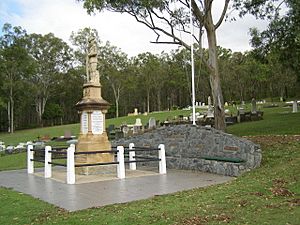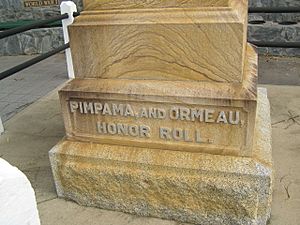- This page was last modified on 17 October 2025, at 10:18. Suggest an edit.
Pimpama & Ormeau War Memorial facts for kids
| Pimpama & Ormeau War Memorial | |
|---|---|

Pimpama and Ormeau War Memorial, 2007
|
|
| Location | Pacific Highway, Pimpama, Queensland, Australia |
| Design period | 1914 – 1919 (World War I) |
| Built | 1919 |
| Official name: Pimpama & Ormeau War Memorial | |
| Type | state heritage (built) |
| Designated | 21 October 1992 |
| Reference no. | 600004 |
| Significant period | 1919– |
| Significant components | memorial surrounds/railings, memorial – soldier statue, views to |
| Lua error in Module:Location_map at line 420: attempt to index field 'wikibase' (a nil value). | |
The Pimpama & Ormeau War Memorial is a special monument located on the Pacific Highway in Pimpama, Queensland, Australia. It was built in 1919 to remember local soldiers. This memorial is listed on the Queensland Heritage Register, which means it's an important historical site.
Remembering Our Heroes
Building the Memorial
Local people from Pimpama and Ormeau built this war memorial. It stands in the grounds of the Pimpama Uniting Church. The monument was made by Andrew Lang Petrie and Son, a company from Toowong, Brisbane. They built many war memorials across Queensland. The memorial cost about £154, which was raised by people donating money.
Pimpama and Ormeau's Past
The towns of Pimpama and Ormeau grew a lot in the 1880s. This happened when the railway line was built between Brisbane and Southport. The Methodist church, where the memorial is, was built in 1880. The memorial was placed in the church cemetery in 1919. It remembers six local men who died in the First World War.
Why War Memorials Are Important
Before the First World War, Australia didn't have many public monuments. But after the war, many memorials were built. These became our first national monuments. They showed how much the war affected a young country. Australia lost 60,000 people out of about 4 million. This was a huge loss.
People felt a lot of sadness, and building memorials was a way to show it. These memorials were like sacred graves. They were for soldiers whose bodies were buried far away in Europe and the Middle East. The word "cenotaph" means "empty tomb." It was often used for war memorials.
Honoring All Who Served
Australian war memorials are special. They don't just remember those who died. Australians were proud that their army was made up of volunteers. These men were honored whether they died or not. Many memorials honor everyone from a town who served in the war. This helps us understand how communities were involved.
These memorials also show how people felt about their country. They show the skills of local stonemasons and artists. In Queensland, statues of soldiers were very popular. Other states often used tall, pillar-like monuments called obelisks.
The "Digger" Statue
The "digger" statue is the most common type of memorial in Queensland. It represents the ANZAC spirit. This spirit includes qualities like loyalty, courage, and youth. The digger statue was unique to Queensland. Other states had groups of artists who helped design memorials.
Most digger statues were made by local stone companies. A L Petrie and Son made the most. They were the biggest stone company in Queensland at that time. The statue at Pimpama is an early example of their style.
A New Digger for the Memorial
Over time, the original sandstone digger statue at Pimpama started to wear out. Its arms, head, and hat were breaking. In 1993, the memorial was moved again within the church property. The committee decided to get a new statue made.
A new sandstone digger was created by R C Zeigler Monuments in Toowoomba. It was unveiled on ANZAC Day in 1995. The rifle on the statue had already been replaced because of damage. The original digger statue was given to the Miles Historical Village.
What the Memorial Looks Like
The Pimpama Memorial is easy to see from the Pacific Highway. It's about halfway between Brisbane and the Gold Coast.
The memorial is made of stone. It has a base with steps. On the front of the lower step, it says "Pimpama and Ormeau Honour Roll."
Above the steps is a pedestal. This part has marble plates and stone columns at each corner. The front plate lists the names of seven local soldiers who died. The side plate has a special message and a patriotic poem.
On top of the pedestal is a square stone plinth. Carved flags, like the Australian flag and the Union Jack, are on the front. You can still see some red, white, blue, and gold paint on them.
The digger statue stands on top of the plinth. The soldier stands at attention with his head bowed. His rifle is reversed, and his hands rest on top of it. A tree trunk behind him helps support the statue.
The whole memorial is surrounded by a low fence. It has white concrete posts and white steel rails.
Why This Place is Important
A Piece of Queensland's History
The Pimpama & Ormeau War Memorial shows an important part of Queensland's history. It represents a time when many communities built memorials. These monuments show how much people loved their country, especially during and after the First World War. They are a unique record of that time.
A Special Kind of Memorial
Built in 1919, this memorial is a great example of a monument built to remember a major historical event. It uses special materials and designs. As a digger statue, it's a common and important type of memorial in Queensland.
Beautiful and Well-Known
This statue is also beautiful because of its excellent design and how well it was made. It's a very visible and well-known landmark in the area. It's also special because of its unusual message and patriotic poem.
Important to the Community
The memorial is very important to the local community. It shows how much a big historical event affected them. It's probably one of Queensland's most famous digger memorials.
Work of Important Builders
This memorial also shows the work of the important stone company, A L Petrie and Son.

